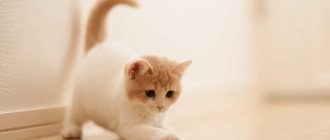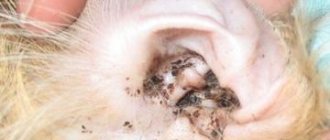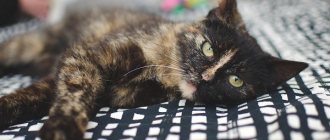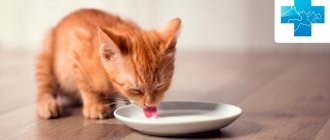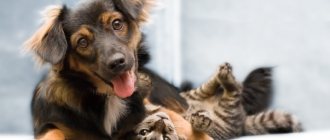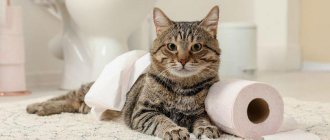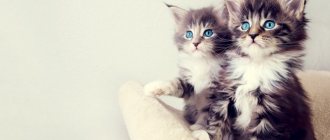If the kitten is healthy, this is immediately obvious: it constantly runs, climbs into strange places, hunts for enemies visible only to it, or for birds in the window.
Like human children, cat babies cannot plan their energy distribution. The kids will play and fuss until they fall asleep right there, buried in their toys.
How to properly give an enema to a small kitten.
How to properly give an enema to a small kitten.
How to properly give an enema to a small kitten.
How to properly give an enema to a small kitten.
A balanced diet is very important for a growing body. The kitten's body is very sensitive and demanding of food. Anything that goes wrong immediately results in either diarrhea or constipation.
A conscientious owner should pay special attention to choosing the right food for a small kitten.
But if constipation occurs, you need to know how to get rid of it gently and safely.
Causes of constipation
With prolonged feeding of solid food and a sedentary lifestyle, stagnation of chyme mass may form in the small intestine. This is the semi-digested contents of the kitten's stomach.
This phenomenon is called chemostasis.
If a kitten is fed bones, a plug of dry feces may form in the small intestine. It will clog the lumen and reduce intestinal permeability to zero.
The intestines can become blocked by accidentally swallowed objects, hairballs, or worms.
How can you tell if your kitten is constipated?
Usually it is not difficult for the owner to guess that the kitten is not in the best shape. The baby behaves restlessly, which is associated with the occurrence of colic, shortness of breath and vomiting. The abdomen swells due to accumulated gases; the animal cannot go to the toilet for more than two days.
If you try to palpate the abdominal wall, then, with certain skills and dexterity, you can feel an oblong lump or foreign body in the intestine.
With intestinal obstruction, in addition to the above symptoms, fever is added, the pulse becomes rapid, and breathing becomes intermittent.
Other reasons for an enema
An enema is not only done to relieve constipation. Indications may also include poisoning or severe exhaustion. In the first case, it is needed to quickly remove harmful substances from the body. And in the second - to quickly feed the kitten if it cannot eat.
Enemas can also be medicinal, when it is not possible to administer the medicine in any other way, and relaxing - to relieve intestinal spasms.
How to properly give an enema to a small kitten.
How to properly give an enema to a small kitten.
How to properly give an enema to a small kitten.
How to properly give an enema to a small kitten.
Brief conclusions
The process is unusual and painful for a cat, so it is not recommended to start an enema without preparation.
Here are the basic tips:
- We carry out the procedure on an empty stomach, preferably in the morning.
- We use only the recommended solution in the dosage that can be administered according to the weight and age of the pet.
- Making an enema with Microlax is the easiest and safest way. But before that, be sure to read the instructions.
- We remember that constipation can be caused not only by stool clots, but also by congenital anomalies or inflammatory diseases.
- If an enema does not help, be sure to listen to the veterinarian’s recommendations, or better yet, visit the clinic (for an ultrasound and tests).
- You can’t exclude natural products from your pet’s menu, including fermented milk and vegetables.
- Special premium canned foods perfectly regulate the gastrointestinal tract to stimulate peristalsis. Probiotics and feed additives do the job just as well.
Remember: an enema is a simple, but very serious procedure that can both help and harm. This express method can remove the consequences of gastrointestinal disturbances, but it does not cope with the cause of the disease.
Therefore, when starting to cleanse the intestines, treat everything that happens responsibly. If the injected solution does not help the cat to empty its intestines, it is better not to hesitate and immediately seek professional advice. Be sure to monitor the animal’s further well-being after the procedure.
And if your cat, on the contrary, has diarrhea, read how to treat it at home.
How to do an enema yourself
First of all, you must be sure that an enema is necessary and that constipation is not caused by volvulus or obstruction.
It is best to use a small bulb, although you can make an enema with a large syringe with a wide hole.
All procedures should be performed in the bathroom or on the bare floor so that it can be easily washed later. There should be a cat litter box nearby. And stock up on napkins or unnecessary rags.
The water in the pear should be warm. For lubrication, use Vaseline, baby cream or regular vegetable oil.
When everything is ready, place the kitten on your lap with its muzzle facing you, holding its head and back between your legs. Be careful: you should measure your strength with the size of the kitten. Make sure he can't escape and at the same time don't choke him.
Lift the kitten's tail, lubricate the anus with Vaseline and insert the tip of the bulb into the rectum. It is enough to immerse it 1-2 cm. Gently press the bulb and pour the water from it into the kitten. The volume of water should be in the range of 50-100 ml.
Then remove the bulb, gently squeezing the anal folds so that the water does not flow out immediately. If the kitten allows, you can lightly massage its tummy to enhance the effect.
After the procedure, do not let the kitten run around the apartment or hide in other rooms. Keep him in the same room as the litter box. So that he can easily reach it (perhaps with your help) when he wants to go to the toilet.
When does a cat need an enema for constipation?
The reason for the procedure may be various obvious symptoms of constipation, as well as a general deterioration in the pet’s condition:
- Long-term absence of stool – in cats up to 3-4 days. Or there is stool, but it is visually determined as unnatural for a healthy animal.
- The general health of the cat is cause for concern - there is no appetite, the cat is lethargic, goes to the toilet, but feces comes out in small quantities.
- A tight belly, discomfort caused by any touch to the abdomen - the cat itself will show you by its behavior that something untoward is happening.
- The animal cannot empty itself on its own - the cat meows, behaves unnaturally, there are attempts to go to the toilet, but they were not successful.
- Vomiting and malaise - the cat is lying down and does not even approach food, there has been no stool for several days - the pet’s well-being is clearly alarming.
Read how else you can cure constipation in a cat.
It's easier with an assistant
If you have a helper, trust him to hold the kitten. And carry out all the procedures yourself. This will free up your hands and make it more convenient.
How to properly give an enema to a small kitten.
How to properly give an enema to a small kitten.
How to properly give an enema to a small kitten.
How to properly give an enema to a small kitten.
“Cuckoo” or nasal lavage using the Proetz fluid movement method
A method developed by American otorhinolaryngologist Arthur Proetz more than a century ago. For many years it was used by ENT doctors to treat acute diseases of the nose and paranasal sinuses.
Russian ENT doctors prescribe “cuckoo” for almost any patient complaint, from acute rhinitis and sinusitis to acute adenoiditis and eustachitis. Washing technique: the patient lies on his back (less often sits), an antiseptic solution is pumped into one half of the nose, and removed from the other using suction. During the procedure, he is asked to pronounce the word “cuckoo” to reduce the likelihood of the solution getting into the throat and larynx (this causes the soft palate to rise, closing the nasopharynx). However, there is still a high risk of liquid entering the respiratory tract, especially in children who do not always understand what is required of them and behave restlessly.
Due to the creation of negative pressure in the nasal cavity, “cuckoo” can be traumatic for the inflamed mucous membrane of the nasal cavity, and if there is severe swelling in the nose and nasopharynx, it can be painful for the ears.
The use of “complex compounds” for rinsing is less preferable than saline solution. Antiseptics can additionally dry out the inflamed mucous membrane of the nasal cavity. Adding antibiotics to the solution also does not provide a therapeutic effect (in “cuckoo” it is often the reserve antibiotic dioxidine; its side effects are dangerous: experimental studies have shown that it has a mutagenic and damaging effect on the adrenal cortex). The addition of hormonal drugs such as dexamethasone or hydrocortisone is also not justified - there are more suitable hormones for use in the nasal cavity (mometasone, fluticasone, budesonide, etc.). If indicated, these sprays can be successfully used; however, they have low bioavailability, that is, they act only in the nose, without having a systemic effect on the body and without significant side effects.
It has been proven that nasal rinsing with positive pressure (Dolphin balloon, Neti pot) is more effective. Such rinses are especially effective for allergic rhinitis and chronic sinusitis.
Important to know : in acute bacterial sinusitis, it makes sense to discuss the use of oral antibiotics only. Neither topical antibiotics nor local antiseptics are indicated, even as an adjunct to treatment.
Veterinarian recommendations
As recommendations, here are the veterinarian's notes:
- The best time to perform an enema is early in the morning.
- Talk to your pet, stroke him. Your calmness and calming tone will prepare the cat, and he will be more willing to trust you.
- Massaging the cat's abdomen under the pelvis will help loosen the fecal impaction. It is in this area that you can feel hard stool.
- Pay attention to the color of the feces excreted with the solution. If they are stained with blood, this may indicate injury to the rectum. This situation requires the intervention of a specialist.
Author of the video channel “And the veterinarian is against!” Veterinarian by profession. In this video, he talks about when to give an enema to a cat.
Sorry, there are no surveys available at this time.
Residue-free diet before colonoscopy
The most common questions that arise when discussing a slag-free diet: what foods can be consumed, and what should be avoided without fail?
The category of waste foods includes foods that result in bulky stools and bloating. These products must be abandoned 3 days before the examination. The following foods should be excluded from the diet:
- fresh vegetables (carrots, white cabbage, onions, garlic, turnips, radishes, radishes, beets);
- millet, pearl barley, oatmeal;
- greens (spinach, sorrel);
- legumes (beans, peas, beans, lentils);
- nuts;
- black bread;
- berries (raspberries, gooseberries)
- fruits (apples, dates, oranges, apricots, peaches, grapes, raisins, bananas, tangerines);
- kvass, carbonated products;
- milk.
The following products can be consumed:
- dietary broths;
- dairy products;
- lean fish, beef, poultry;
- bakery products made from wholemeal flour.
The last meal of the day before the procedure can be no later than 12-00. You can drink plain and mineral water, tea. For dinner there is only tea. On the day of the colonoscopy, you can have breakfast only with liquid.
Preparation with Flit
Fleet is a drug that appeared relatively recently, its popularity is rapidly growing, many patients have been convinced of the effectiveness of the drug from their own experience.
Rules for preparation using the drug Flit
- Take in two doses.
- 45 ml of the product is diluted in half a glass of water and consumed immediately after breakfast;
- the second dose (45 ml) - in the evening after a diet dinner.
- If the patient has time, you can take another dose in the morning on the day of the examination, no later than 8-00.
- Breakfast and dinner should include only 1 glass of water.
- Lunch should be dietary and include no more than 750 ml of water.
- Each dose of Flit should be washed down with 1-3 glasses of cold water; after taking the drug, the liquid can be consumed in unlimited quantities.
- Fleet begins to act approximately 30 minutes after administration.
Video “Enema for a cat at home”
In this story from the “Children of Fauna” channel, its author, a veterinarian by profession, tells and shows how to give an enema to a cat.
Was this article helpful?
Thank you for your opinion!
The article was useful. Please share the information with your friends.
Yes
No
X
Please write what is wrong and leave recommendations on the article
Cancel reply
Rate the benefit of the article: Rate the author ( 7 votes, average: 4.14 out of 5)
Discuss the article:
Fortrans drug for preparation for colonoscopy
Drug Fortrans
The effect of the drug Fortrans is to cleanse the intestines without absorption into the gastrointestinal tract; the drug is excreted unchanged. Preparation using Fortrans is extremely simple: a package of the product is diluted in 1 liter of water. For 20 kg of patient’s body weight - 1 liter of solution. There are two methods of using the solution:
- The drug is taken in the evening, starting from 15-00, 1 glass, at intervals of 1 hour;
- Half of the solution is taken in the evening, the rest in the morning.
The last time you should take Fortrans is 3-4 hours before the examination. The drug is intended directly for the cleansing stage preceding X-ray, endoscopic examinations, and operations on the colon.
